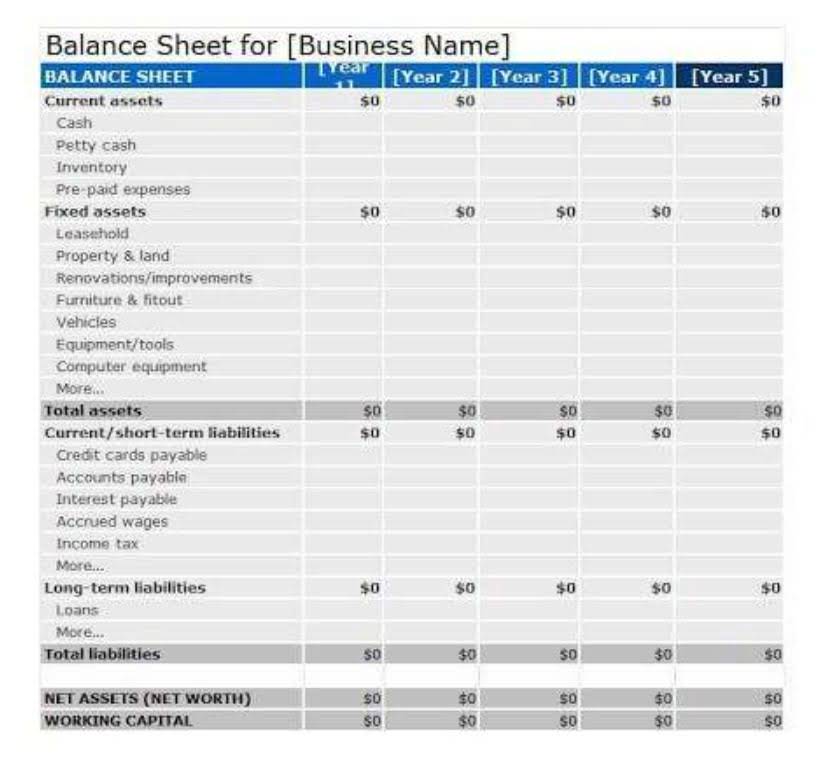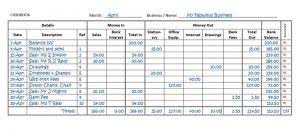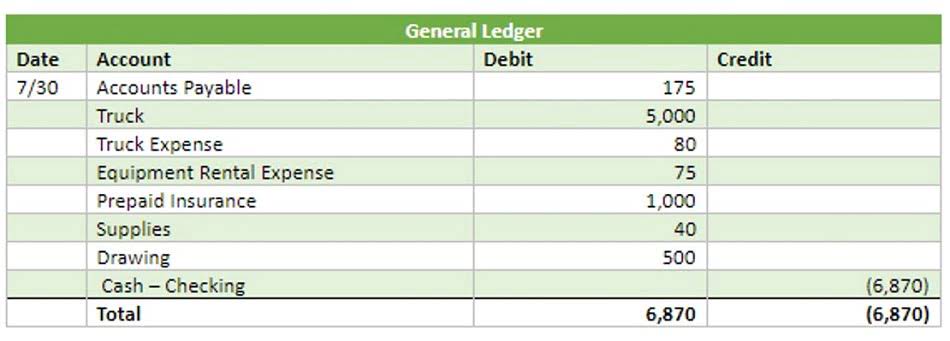Kategori: Bookkeeping
The Normal Balance of Accounts Full Guide for 2025
A solid understanding of debits and credits helps keep financial records clear and effective. Accounting transactions change general ledger accounts through these entries. This shapes the financial story of both personal and business finances. For example, assets and expenses, which are about spending or using up value, normally have a debit balance. Meanwhile, liabilities, equity, and revenue represent money coming in or claims on the company. An asset is anything a company owns that holds monetary value.
You can use a cash account to record all transactions that involve the receipt or disbursement of cash. Ed’s inventory would have an ending debit balance of $38,000. Modern tools like QuickBooks, Xero, NetSuite, Bench, Pilot, and FreshBooks make it easier to keep track of account balances. They follow the Generally Accepted Accounting Principles (GAAP), making tasks simpler and more reliable. Entities should also aim to refill their fund balances in one to three years. This considers things like the economy, recovering from big events, and planning finances.
Exploring the Concept of Normal Balances in Accounting
Cash on hand should never have a net credit balance, since one cannot credit (pay from) cash what has not been debited (paid in). It would properly be reported as an asset, and possibly written off to a zero balance if the overpayment is not recoverable. Furthermore, understanding the normal balance in financial statements aids in financial analysis and decision-making. It allows stakeholders to assess the financial health, profitability, and liquidity of the company by evaluating the trends and relationships within the financial statements. The significance of these balances extends beyond mere record-keeping; they are essential in painting a true picture of a company’s financial position. Missteps in this area can lead to distorted financial statements, misinformed decisions, and potential compliance issues with accounting standards.
By understanding the normal balance concept, you can correctly record transactions, such as the cash normal balance of accounts injection and the equipment purchase, in your double-entry bookkeeping system. Remember, the normal balance is the side (debit or credit) that increases the account. For asset accounts, such as Cash and Equipment, debits increase the account and credits decrease the account.
This means that when you increase an asset account, you make a debit entry. For instance, when a business buys a piece of equipment, it would debit the Equipment account. Accordingly, Assets will normally have a debit balance and Liabilities – credit.
When we’re talking about Normal Balances for Expense accounts, we assign a Normal Balance based on the effect on Equity. Because of the impact on Equity (it decreases), we assign a Normal Debit Balance. When we’re talking about Normal Balances for Revenue accounts, we assign a Normal Balance based on the effect on Equity.
Keeping transactions consistent is crucial for trustworthy financial reporting and analysis. An expense account is a normal balance asset account that you use to record the expenses incurred by a business. To understand debits and credits, you need to know the normal balance for each account type. The normal balances of accounts are important to consider when preparing financial statements. Accounts that typically have a debit balance include asset and expense accounts. Ed’s inventory would have an ending debit balance of $40,000 and a debit balance in cash of $15,000.
Cash Flow Statement
The Normal Balance of an account is either a debit (left side) or a credit (right side). It’s the column we would expect to see the account balance show up. Additionally, the use of analytical procedures can provide insights into the validity of account balances. These procedures may include trend analysis, ratio analysis, and other financial diagnostics that compare current data with historical figures, budgeted amounts, or industry standards. Significant deviations from expected patterns can be indicative of errors or irregularities that warrant further investigation. A contra account is an optional accounting tool you can use d to improve the accuracy of financial statements.
- At the heart of this precision lies an understanding of normal account balances—a concept critical to maintaining the integrity of a company’s books.
- This is vital for keeping accurate financial records and showing a company’s financial health.
- Understanding how to read an accounting chart can give you valuable insights into a company’s financial condition.
- There might be transactions that require one debit entry and two credit entries, which must add up to the same amount as that one debit entry.
How to Know What to Debit and What to Credit in Accounting
When an expense is incurred, the debit entry is recorded on the left side of the T-account and the credit entry is recorded on the right side. This means that when invoices are received from suppliers, the accounts payable account is credited, and when payments are made to suppliers, the accounts payable account is debited. A glance at an accounting chart can give you a snapshot of a company’s financial health.
- Meanwhile, expense accounts reflect costs in making revenue, typically having a debit balance.
- The normal balance of an account is not just a static feature; it is dynamically influenced by the business’s transactions.
- Accruing tax liabilities in accounting involves recognizing and recording taxes that a company owes but has not yet paid.
- If the debit is larger than the credit, the resultant difference is a debit, and this is listed as a numerical figure.
- When we’re talking about Normal Balances for Expense accounts, we assign a Normal Balance based on the effect on Equity.
What is the significance of normal balances in maintaining accurate financial records?
It is determined by the nature of an account in the chart of accounts under the double-entry bookkeeping system. Asset accounts, like Cash and Inventory, have a debit for their normal balance. On the other hand, liability accounts like Accounts Payable and Notes Payable have a credit normal balance. Debits increase asset and expense accounts but decrease liabilities, equity, and revenue.
It’s essentially what’s left over when you subtract liabilities from assets. When owners invest more into the business, you credit the equity account, hence, it has a normal credit balance. A contra account is one which is offset against another account. So for example there are contra expense accounts such as purchase returns, contra revenue accounts such as sales returns and contra asset accounts such as accumulated depreciation. Each of the accounts in a trial balance extracted from the bookkeeping ledgers will either show a debit or a credit balance. The normal balance of any account is the balance (debit or credit) which you would expect the account have, and is governed by the accounting equation.
When the value of assets increases, the asset account is debited, and when the value decreases, it is credited. Understanding the normal balance of an account is essential for maintaining accurate financial records and preparing financial statements. It helps identify errors in the accounting system and ensures that financial transactions are recorded correctly. Knowing the normal balance of an account helps you understand how to increase and decrease accounts. Next, we’ll move on to adjusting these accounts with journal entries.
When it comes to the Owner’s Equity, things can get a little confusing because it has a number of components. Just like Liabilities, the Owner’s Equity normally has a credit balance. So, anything that increases the Owner’s Equity will also have a credit normal balance.
Simplified Chart of Accounts for Law Firms

As we discuss in more detail in our guide to trust accounting for law firms, it’s essential that lawyers and law firms correctly manage client funds in trust. By doing so, lawyers can stay compliant with the exact trust accounting rules for their applicable jurisdiction. For most law firms, this means having at least three bank business bank accounts—including a chequing account, a savings account, and a separate IOLTA or trust account. The most unique feature of the law firm’s chart of accounts and law firm bookkeeping is the IOLTA or trust account. The lawyer does not own the funds in this account, so it must be recorded on a per-client basis. Create separate bank accounts, to avoid any commingling of client funds and operational funds.

Sample Chart of Accounts for Law Firms

It’s also important to keep accurate records and track funds in general retainers. Unearned fees (like general retainers) should be kept in a separate account so that they are not used in error. These simple modifications to your accounting records are quick and easy, and they will give you a great deal of clarity, especially about the expenses your firm is incurring. Irvine Bookkeeping offers a full range of Law firm bookkeeping services and promises that in 2-3 weeks, we clean up a whole book for you to prepare for tax season.
Accounting terms you need to know
And the transaction records feed into the firm’s balance sheet and income statement. By including general retainers in a law firm’s chart of accounts, you can more easily monitor these accounts. If you’re seeking a unified solution for case management and legal accounting, Clio could be the perfect fit. Conversely, cash basis accounting recognizes revenue when you’re paid (i.e., when the cash is received) and expenses when they’re paid. The tax implications of this method also allow your firm to pay tax on income once it’s received and in the bank.
- With Clio Accounting you can generate all sorts of financial reports to help you make data-driven decisions for the growth of your firm.
- As we showed with the law firm chart of accounts samples in this post, the exact details of the chart will vary depending on your firm’s situation and jurisdiction.
- Likewise, if the law firm experiences a period of low cash flow, it may be able to use its assets as collateral to secure a line of credit or other form of short-term financing.
- These amounts include reimbursable client costs, non-reimbursable client costs, and advanced client costs.
- This overview covers the elements that comprise a standard accounting chart, along with practical tips for implementing the chart into your firm.
Integrating the Chart of Accounts with CaseFox
- Your firm’s various financial accounts are organized under these categories.
- Also, you can use a legal-specific template provided by your accounting software.
- Your best bet is likely to hire both a legal bookkeeper and a legal accountant.
- The most unique feature of the law firm’s chart of accounts and law firm bookkeeping is the IOLTA or trust account.
- It not only ensures compliance and accuracy in financial reporting but also serves as a strategic tool for making informed business decisions.
- When set up correctly, a law firm chart of accounts provides an accurate picture of your law firm’s financial situation now, contra asset account and as you move forward.
Assessing your law firm’s unique financial requirements is crucial for an effective chart of accounts. Every law firm operates differently, with distinct practice areas and billing methods. By understanding your firm’s financial landscape, you can tailor your chart of accounts accordingly. This ensures accurate financial recording, streamlined reporting, and better insights into profitability.
Trust accounts are one of the most common areas where legal accounting mistakes are made. Whether you mismanage the accounts, put funds in the wrong account, accidentally use funds, or fail to report correctly, trust accounting errors are a big deal in accounting for law firms. Trust accounting mistakes can lead to penalties, suspension, or even losing the right to practice law. To ensure your firm’s financial statements are accurate, complete, and up-to-date, you need to use sound bookkeeping for Certified Public Accountant attorneys. Integrating your chart of accounts with CaseFox software streamlines financial management processes for your law firm. This integration offers automated data entry and synchronization, eliminating manual input and reducing errors.
What to look for in a legal bookkeeper
Addressing those compliance issues requires a proper, lawyer-specific chart of accounts. Creating and managing a law firm chart of accounts doesn’t need to be a completely manual endeavor. Technology can make accounting processes—including setting up your law firm chart of accounts—easier, more efficient, and more accurate for law firms. To further streamline your accounting processes, use a legal-specific accounting solution. Personal and business finances should be separate to ensure that bookkeeping is accurate and compliance is maintained.

By categorizing transactions in a consistent manner, a well-structured chart of accounts enhances the firm’s ability to track income and expenses. Also, it facilitates monitoring of cash flow and identifies financial trends or anomalies. Also, certain complex transactions, such as those involving client trust funds or partner distributions, require an understanding of both legal and accounting principles. Misclassification of transactions can lead to Certified Bookkeeper inaccurate financial reports and potential regulatory issues.
This involves identifying and categorizing all the financial transactions that a law firm expects to handle. A properly structured chart of accounts is crucial for accurate financial reporting and helps maintain regulatory compliance. Organize your accounts by category to make it https://www.bookstime.com/articles/law-firm-chart-of-accounts easier to track your law firm’s finances. Some categories you may consider include income, expenses, assets, liabilities, and trust accounts.
What is Sales Revenue? How to Calculate it with Formula

In other words, businesses utilize this statistic to assess how Online Accounting effectively their primary sources of revenue are generating profits. Apply the above gross sales revenue calculators to each type of product or service you sell. Then, add up the totals for each product and service to get your overall sales revenue. You calculate sales revenue differently depending on whether you sell products or services. Here’s how to calculate gross and net sales revenue for each, followed by a detailed example you can use as a template to work out your revenue figures. Net sales revenue is gross sales revenue minus returns, discounts and the cost of goods sold (COGS).
- This is a list of steps you can take to improve your sales revenue.
- Of course, I needed to dig deeper than a simple sales revenue definition.
- Let’s take a closer look at how to calculate revenue, including using the sales revenue formula.
- Prospecting campaigns are many businesses’ primary source of growth.
- See how software like Zendesk Sell can help you generate comprehensive sales reports so you have the knowledge and insights to take your business to new heights.
- Sales reps spend 70% of their time on non-selling tasks, according to the same report.
Example of Sales Revenue Calculation (Product-Based Company)

You’re an e-commerce retailer that sells activewear, and you’d like to know the sales revenue for a particular line of leggings in the previous month. When you’re forecasting sales, the last thing you want is a garbage-in-garbage-out situation. But to input clean data, you need to be consistent and accurate when collecting data in the first place.
- It ensures accurate financial reporting by automatically updating inventory values and linking transactions, minimizing human errors and enhancing efficiency.
- When calculating sales incentives, consider the company’s operational costs and potential returns.
- RPL is more of a macro-level metric focused on monitoring your campaign’s yearly or quarterly performance.
- Perform a market analysis, research your competitors, and use customer data to test various price points on each audience segment to help you determine the right price.
- Gross sales revenue includes the total amount of money a company receives from the sale of products or services.
Plan business growth

After gathering your data at different stages of the sales cycle, it’s important to look for strange anomalies, like Food Truck Accounting coding errors or sudden spikes and dips. A good sales process is the foundation of any successful sales organization. Learn how to improve your sales process and close more deals with this free guide. In this article, we’ll unpack all you need to know about sales revenue. We’ll give you a comprehensive sales revenue definition, walk you through how to calculate it, and reveal why it matters so much for sales forecasting. Prospecting campaigns are many businesses’ primary source of growth.
Best practices for driving revenue growth

Master the metrics you need to keep things moving ‘up and to the right’! Our Growth Metrics Cheat Sheet covers 45 metrics to measure success at every stage—from acquisition to revenue and referral. When revenue data is shared across teams, decisions become smarter, growth becomes predictable, and teams work toward the same goal.

This covers any income derived from transactions, investments, or marketing activities. Contrarily, sales income solely takes into account money made from real sales. Even if sales increase, a company’s net income could nevertheless decline if operating, selling, or administrative expenditures increase more quickly than revenues. When sales increases but net income decreases, a company needs to figure out why and search for cost-cutting measures. Look at both your total and net sales to ensure profitability and sound financial management. While your net revenue takes expenses into account, your total revenue provides more insight into your capacity for revenue generation.
- Once competitors see the opportunity and start lowering their prices as well, it might potentially reduce the market’s worth.
- Net revenue appears on the income statement and helps determine profitability.
- Are you aiming towards having a healthy cash flow for financial stability of your business?
- Deskera Books can help you automate and mitigate your business risks.
- The higher your sales velocity, the faster your business brings in revenue—and that’s exactly what every sales team wants.
- Enerpize is an all-in-one online accounting software designed to streamline financial management for businesses of all sizes.
How to calculate gross sales revenue
- This ratio is used to determine a company’s profit before deducting other costs and after subtracting the cost of the goods sold.
- The break-even point is a major inflection point in every business and sales organization.
- It’s no surprise that it dominates conversations from salespeople to management.
- The sales velocity formula gives you a quantifiable way to measure how quickly your sales team is generating revenue.
- Analyzing sales revenue is crucial to understanding financial health, reporting accurate profits and making better forecasts.
- When sales increases but net income decreases, a company needs to figure out why and search for cost-cutting measures.
It is the foundation of any financial analysis of the current position, forecasting the future performance and planning for further development and expansion. By sales revenue formula implementing clear payment terms and automated invoicing, businesses can track DSO over time and reduce outstanding balances. No matter what department you work in, whether it’s AR, sales, or finance, understanding your company’s DSO is vital for supporting long-term growth. Reducing DSO is essential when it comes to maintaining your business’s financial health.
What Is Full-Time Equivalent FTE and How To Calculate It?
The Paycheck Protection Program (PPP) provides funds for small business owners to help them cover up to 24 weeks of payroll or other costs such as utilities, rent, etc. Bear in mind that these are just simple FTE example calculations — project managers approach FTE from a different angle, while federal programs use different FTE calculation methods. With over a decade of experience as a journalist and content professional, David leads the production of industry-leading content to help professionals take their businesses to the next level. He is passionate about creating engaging, informative, and thought-provoking content that resonates with readers.
Sudden changes or churn in FTE numbers can serve as an early warning for HR of underlying staffing problems or challenges. The Workday Illuminate platform is designed to enhance business decision-making by leveraging advanced artificial intelligence and machine learning capabilities within the Workday ecosystem. Workday also offers augmented analytics applications and connects enterprise applications to a unified data model for improved decision-making.
- FTE holds significant importance for HR professionals as it provides a standardized metric for assessing employee workload and tracking cost savings.
- Adjustments to FTE in Workday necessitate modifying employee status and updating workload and FTE values, ensuring organizations have accurate data for workforce planning and resource allocation.
- To easily calculate your employees’ FTE, try out Clockify — a time tracking tool that can also be of great help for identifying your employees’ FTEs.
- By comparing actual output against their FTE allocation, managers can assess productivity and identify areas for improvement.
Not sure how to get started with your project?
A part-time graphic designer working 30 hours per week at that same company would have an FTE of 0.75 since they work 75% of that 40 hours. An understanding of FTE also helps employers decide when to hire staff for short-term projects. In this way, scheduling projects based on the FTE calculation allows for greater accuracy in workforce planning and the efficient allocation of resources.
We’ll be happy to explain how to determine FTE for different contract types and give you tips on how to prevent errors. To be required to provide COBRA continuation coverage, a company must employ at least 20 full-time equivalent employees on more than half of its working days in the past year. The Employee Retention Credit (ERC) is another measure designed to incentivize employers to keep hold of staff during the COVID-19 pandemic. It comes in the form of a tax credit worth half of employee wages over the course of a covered period.
FTEs calculator for the Paycheck Protection Program (PPP)
Knowing the FTE (Full-Time Equivalent) for HR is crucial for effectively managing part-time workers, controlling labor costs, and making informed decisions on benefits and PTO (Paid Time Off) accrual. The FTE calculation helps HR professionals assess the productivity and effectiveness of part-time employees, improving overall workforce planning and management. Unlike headcount, FTE considers both full-time and part-time workers within the organization. This comprehensive view allows businesses to decide when to hire part-time or full-time employees.
Unpaid interns typically do not receive compensation for their work and are not considered employees in the same way as paid staff members. Imagine that, with the same FTE, an employee can deliver 100 units, while another only delivers 30. In this case, the calculation may show that the first professional is overqualified for the position, whilst the other needs more training and development. For example, the UK’s National Insurance Contributions (NICs) are calculated based on an employee’s weekly earnings.
If you have salaried non-exempt staff, though (e.g., mechanics or live-in help), they’re eligible for overtime hours and you may want to know their FTE count. Unless you’re going with the IRS benchmark (30 hours a week), decide what number of weekly hours is the standard for a full-time position in your company. The theoretical “employee” in your FTE calculation works this standard number of hours. For example, under the Affordable Care Act (ACA), companies with 50 FTEs and over are considered Applicable Large Employers (ALE) and must provide ACA-compliant benefits to full-time workers. Your full-time equivalent (FTE) is the hypothetical number of full-time employees who’d be working all the hours your team works.
HR can analyze the FTE ratio of part-time to full-time workers, enabling them to evaluate the cost-effectiveness of utilizing part-time employees versus hiring additional full-time employees. This information helps determine whether it is more economical to maintain a higher number of part-time workers or shift towards a larger full-time workforce. If the employees work the same number of hours every week (especially part-time employees), the FTE will be the same every week.
- Accurately tracking these hours provides a comprehensive view of the workforce’s total effort.
- By understanding and properly applying FTE, companies can optimize their workforce, improve task planning and assignment, and make informed decisions that drive productivity and overall profitability.
- The Workday Illuminate platform is designed to enhance business decision-making by leveraging advanced artificial intelligence and machine learning capabilities within the Workday ecosystem.
- Each part-time employee counts as a fraction of one FTE based on how many hours they work on average.
- This can help optimise labour costs, enhance productivity and support overall business success.
What Is Full Time Equivalent (FTE) and How to Calculate It?
FTE values that are greater than 1.0 represent a greater workload that goes beyond a single full-time employee, while values less than 1.0 represent part-time workloads. FTE is an incredibly useful metric for organizations looking to assess and quantify the total labor resources available within their workforce. It provides a standardized measurement that companies can use to compare the productivity and capacity of their different departments, teams, or projects. This tells you how many FTE employees your part-time workers add up to. Add this to the number of actual full-time employees 0.75 fte meaning you have to find your total FTE. By adhering to these best practices, organizations can optimize their workforce management and make data-driven decisions about staffing and resource allocation.
razones del porqué se debe cuidar el SEO de tu Content Marketing
There are companies that have a significant number of people working part-time, i.e., workers who spend only a short time in the company. FTE is the number of determined full-time positions in an organisation. This content is based on generally accepted HR practices, is advisory in nature, and does not constitute legal advice or other professional services.
Step #2: Define your standard working hours per week
If you go beyond the basic calculations, you sometimes end up in more complex situations. Here, we’ll discuss how to calculate FTE in special cases, such as seasonal or project-based work, and how overtime and leave can influence your calculations. Workday Orchestrate is a powerful integration tool designed to streamline and automate business processes across Workday and third-party systems. Users can modify an employee’s workload using the ‘Change Work Space’ or ‘Change My Work Space’ task in Workday. When employees’ workload is updated, their FTE value will be automatically adjusted.
If you, for instance, choose the first method, enter all the actual hours worked (including PTO) and divide that number by 2,080 to get the final FTE. All you need to do is enter how many hours of work are required to complete the whole project (estimated time) and then how many hours a day your employees will work on that specific project. First and foremost, make a list of all your employees within an organization.
This can help you get a more accurate picture of their contribution, even if their working hours vary. A full-time equivalent (FTE) is the number of hours worked in a week divided by the employer’s hours for a full-time workweek, which is typically 40 hours. Users can access the Workday Time or Time Tracking application, select the week to enter, input the hours worked, and submit the data once completed for the week. Accurately entering employee work hours ensures proper approval and compensation, adherence to labor laws, and transparency and accountability in the system. By following these steps, organizations can accurately calculate FTE for various employee types, aiding in resource planning, budgeting, and compliance reporting. Since they are receiving compensation for their work, they contribute to the organization’s overall workforce capacity.
To be able to calculate the total FTE in your company, you need to determine the FTE of your part-time workers first. To do that, you need to divide the total number of hours worked by your part-time employees by the total number of annual hours worked by 1 full-time employee. Compliance with company policies ensures that employees are treated fairly and consistently, promoting a positive work environment and employee satisfaction. Workday can assist in ensuring compliance with labor laws and company policies by providing a centralized system for managing employee data and tracking work hours.
Basic Bookkeeping for an S Corporation

While it is the shareholder’s responsibility to account for basis, an S corporation may wish to inform shareholders of their basis accounting requirements. To summarize, cash-based accounting is ideal for young companies with little-to-no inventory, with simple transactions where money changes hands upon receipt of goods. Accrual Food Truck Accounting basis accounting is better suited for larger businesses with more complex financials, and that have a need to track costs against project revenues. If you have lingering doubts as to which method might be best for your S Corp, get in touch with your CPA, who can help to guide your decision. Accrual basis accounting is suitable for businesses that offer terms on services rendered. For example, an engineering design firm where increments of the lump sum are due and payable upon certain phases being completed.

How Does Cloud Bookkeeping Simplify Financial Management for Small Businesses?
Not every corporation can qualify to be taxed as a subchapter S corporation. The IRS imposes a list of limitations and restrictions that the business and shareholders must meet and continue to comply with at all times. An S Corporation is formed the same way a regular C Corporation is, a corporation is a legal entity created under the laws of a particular state.
Bookkeeping services with corporate taxes prepared.

Freshbooks lets you do basic tasks in as little as 2 minutes, regardless of invoicing a client, recording a payment, or the time spent on a project. Due to these differences, bookkeeping for s corp if the S corp wishes to revert back into a C corp, the same retained equity account cannot continue being used. Additional calculations would need to be made in order to reconcile the accounts to reflect the proper balance. As you’re building your new S Corp, you need to be certain that you’re compensating your employees correctly. Too little or too great compensation could cause IRS red flags, and lead to trouble in recruiting and retaining top quality personnel. RC Reports offers a compensation analysis solution for small, medium, and large businesses.

Is this the Right Entity For Your Business?

A business selling services without an inventory can work with cash-based accounting. But, for companies delivering products and maintaining an inventory, accrual-based accounting is a better option. Using accrual accounting vs cash accounting is important when dealing with S corp bookkeeping. The main difference between the two boils down to when you record revenue and expenses.
- S Corporation shareholders are required to adhere to specific reporting requirements set forth by the Internal Revenue Service (IRS) to maintain compliance.
- State laws require corporations to have at least an annual meeting of the board of directors, and the financial statements presented at that meeting come from the corporate accounting records.
- Additional calculations would need to be made in order to reconcile the accounts to reflect the proper balance.
- Shareholder basis, also known as stock and debt basis, is the capital investment made by a shareholder in the S Corporation for tax purposes.
- S corporation owners who also work for the business are also employees, subject to payroll taxes.
Form 1120-S is the tax form S corporations use to report their income, deductions, and losses to the IRS. If you are running retained earnings balance sheet an S corporation, you will need to file Form 1120-S every year, even if you did not have any income or activity during the year. The form is due on the 15th day of the third month after your corporation’s tax year ends.

The biggest challenge in S corp accounting involves the capital accounts of each and every shareholder. The company must maintain meticulous records of each shareholder’s equity investments of cash and property, as well as any loans that each advances to the company. This form would be issued to each shareholder, which outlines their shares of the business’s income, expenses, credits and other tax itemizations. Each shareholder is personally responsible for reporting their relevant part of the S-Corp’s income on their personal tax returns. It’s essential to maintain accurate records of the basis adjustments and report them to the IRS using Form 1120-S, the U.S.


